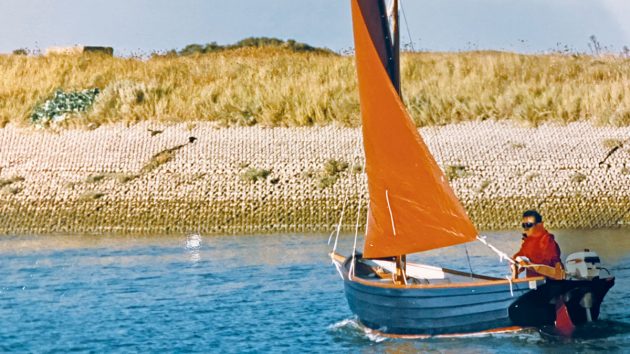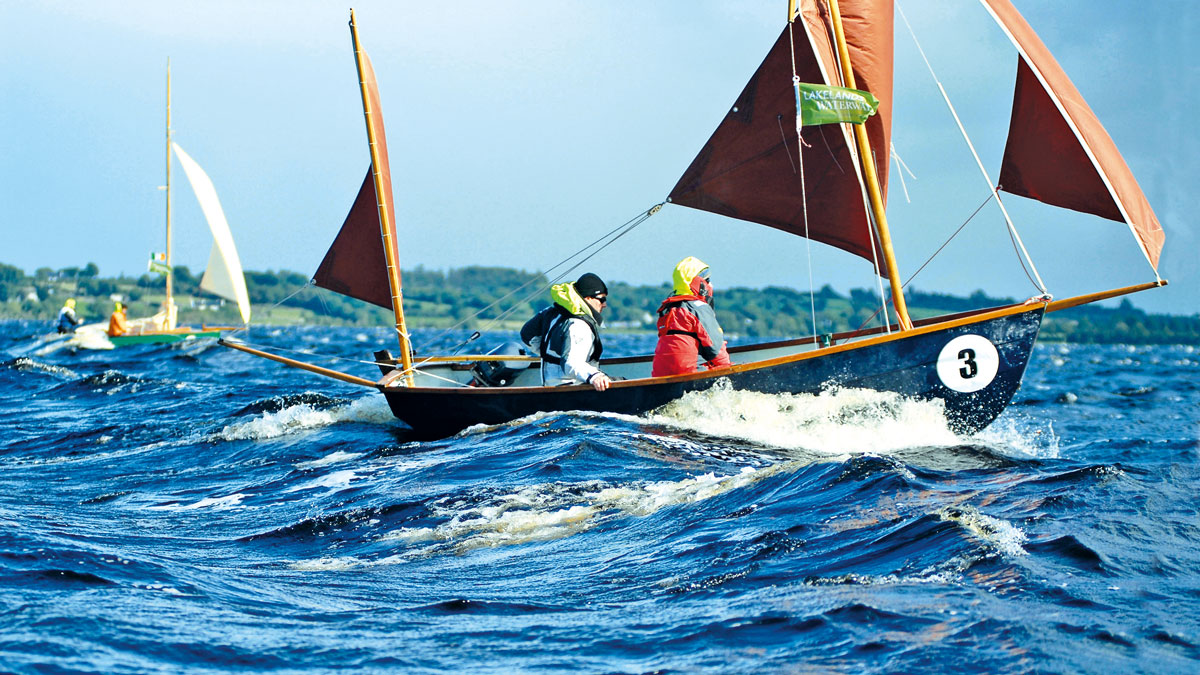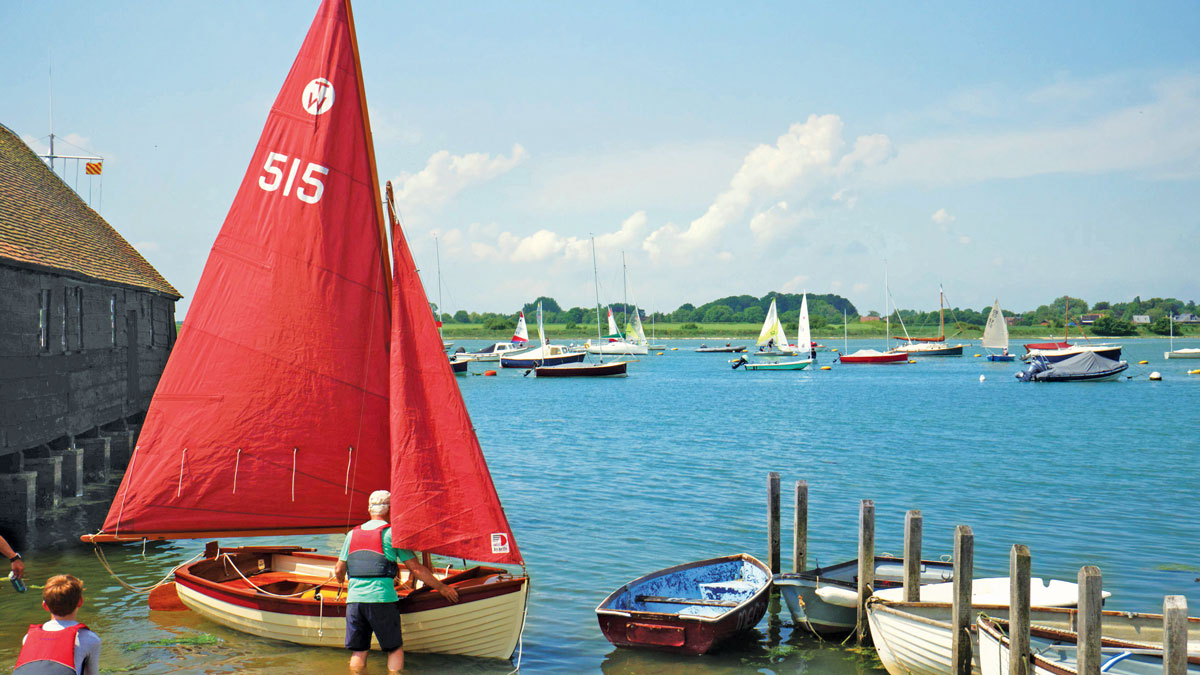The smaller Hastings luggers (22ft or less) are called punts – and Clive Marsh has converted several 16ft versions back to sail
Rye Bay in East Sussex has been one of the UK’s best inshore fishing grounds for centuries and the nearby beach at Hastings is host to what is probably the largest fleet of beach-launched fishing craft in the UK.
These craft all bear the letters ‘RX’ and are based at the Stade on the beach at Hastings and in the river Rother at the nearby ancient town of Rye.
They’re powered by diesel engines but until recently they were entirely driven by sail and referred to as Hastings luggers.

Clive and Maurice coming in to Rye on Clive’s Sussex Punt converted to sail
The smaller boats (normally 22ft or less) are called punts and I have owned several 16ft versions of these which I have converted back to sail power.
I often travel down to Hastings to watch beach operations and buy fish from the stalls, the scallops are amazing.
But, of course, my main interest is in the Hastings boats.
Hastings Boats: design reasoning
The method of landing a Hastings lugger is to race it up onto the shingle, have one of the crew jump off the bow and connect a cable to the tow eye low down onto the front end of the keel where it meets the stem.
The boat is immediately winched up the shingle beach with the aid of greased wooden sleds or gas pipes.
Timing is crucial because the boat must not be allowed to broach in the surf. To avoid broaching these boats have a lute stern or counter stern.

A Newhaven boat showing off her stern
There were two local builders of these inshore punts, HL Phillips & Son’s yard at Rye and R Lower & Sons at Newhaven.
Phillips preferred lute sterns while Lowers preferred elliptical sterns.
With the advent of fibreglass, Meeching Boats built GRP lute-sterned punts for commercial fishing and angling.
The 16ft GRP Meeching punts have a hole in the lute stern to accommodate an outboard motor.
This acts like a semi-well and protects the outboard when moored and also at sea from waves drowning the motor.
Hastings Boats: sea-fit
My wife and I, son, daughter-in-law and grandson decided to take a fishing and leisure trip on the South Coast out of Rye.
Now, this is a huge responsibility and, apart from having a seaworthy boat, I took the following precautions: standby skipper (son Tom), anchor, bailers, personal buoyancy, three oars, spare oar crutches, VHF radio, mobile phone, water, food, spare parts and waterproofs.
We dropped anchor halfway between Rye and Dungeness and daughter-in-law caught her first fish ever.
It was a good-sized mackerel, which tasted as good as it looked with some horseradish and beetroot. It was a very fine and memorable day.
Stepping off the earth for a while is one of the benefits of boat ownership.
These traditional Sussex punts are stable and seaworthy, giving a feeling of confidence to those on board.
Sail conversion
I decided to convert a 16ft Meeching punt to sail, then, in addition to my two outboards and three oars, I’d have another string to my bow.
Hastings fishermen sailed their punts inshore without a centreplate.
The reason for this was that when launching or recovering on the beach, stones would get stuck up the centre plate casing and leaks could occur around the casing.
So I didn’t bother with a centreplate and found that the boat sailed well enough in the open sea, especially if kept on an even keel.
The mast was a 17ft length of 3in x 3in Norfolk pine delivered by Morgan Timber of Strood in Kent and the 11ft yard was made by my mate Maurice by laminating plywood.
Continues below…
Scow boats: sturdy little sea-going vessels
Clive shares his love of the South Coast variety Avon Scow: 11ft lug-sailed boats with a heavy galvanised steel centreplate
Lune Pilot 11: why you should sail this fine, little boat
A very interesting boat with a long keel, which makes it slightly unusual for a dinghy
Sailing in waves in little boats
Why the correct manoeuvres for the sea conditions will reduce hogging and sagging stress on both ship and crew
Tideway 12: seaworthy and stable
Prolific boat owner Clive Marsh extols the virtues of the Tideway 12, which can be launched by hand from a
The mast was oiled with Owatrol Deks Olje and the yard was covered with coats of International marine varnish.
I acquired a good used sail from Arun Sails with two sets of reef points.
By luck the mast, supported by the forward thwart, was in the right position to give an acceptable amount of weather helm, that is the centre of effort just happened to be slightly ahead of the hull’s centre of lateral resistance.
I experimented with this but it all seemed to work well enough if the boat was sailed close to upright.
I also made a leeboard for use when sailing in the narrow river but found it made no significant difference so I dispensed with it.
I had to cut an additional hole through the lute stern to take the outboard because the original hole in the centre was needed to take the addition of a rudder.
The mast was stepped onto a box on the sole and supported by the forward thwart, a forestay and two shrouds.
I tried a number of different sheeting arrangements, being boomless the sheet needed to be pulled well aft in order to get the sheeting angle correct.
Stable craft
My converted 16ft Meeching punt sailed very well and held her course.
She’d tack slowly and have to be steered round, she wouldn’t spin round quickly but, overall she was very reassuring and fun with plenty of space on board due to the lack of a centreboard case.
It’s a great open family or fishing boat.
Some Hastings punts were only 14ft in length.
Boatbuilder Ian Sheerer took a moulding from one of these small punts and exhibited her at the Southampton International Boat Show as the Winchelsea Lugger.

Our Pam & Peter, a typical Hastings beach boat, aims for the Stade beach
I bought and sailed her for some years from Chichester and other South Coast locations.
Ian had extended the long keel to make it deeper and had also designed and built in a cunning water ballast system.
This gave the boat greater stability but would drain away when I was pulling the boat up a slipway.
A good place to visit to see working beach boats going about their business is the Stade at Hastings where you can also peruse some restored traditional boats including a nice punt built by Phillips of Rye.
While there pop into the Hasting’s Fishermen’s Museum in the former fishermen’s church of St Nicholas.
Inside, there are a host of models and items of interest to those who like working boats.
You can also step onboard the Enterprise, Hastings’ last sailing lugger.
With the cost of fuel and engine maintenance, I often wonder how long it will be before commercial fishermen in the bay discover sail again?
I liked my little sailing luggers.
Enjoy reading Hastings Boats: stable and seaworthy dinghies?

A subscription to Practical Boat Owner magazine costs around 40% less than the cover price.
Print and digital editions are available through Magazines Direct – where you can also find the latest deals.
PBO is packed with information to help you get the most from boat ownership – whether sail or power.
-
-
-
- Take your DIY skills to the next level with trusted advice on boat maintenance and repairs
- Impartial in-depth gear reviews
- Practical cruising tips for making the most of your time afloat
-
-
Follow us on Facebook, Instagram, TikTok and Twitter








